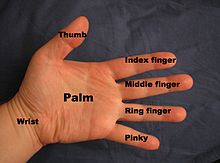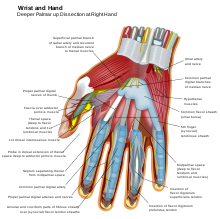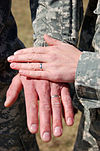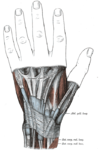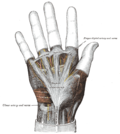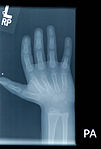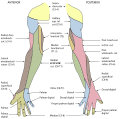- Hand
-
For other uses, see Hand (disambiguation).
Hand 
Palmar and Dorsal aspects
of human left handLatin manus Vein dorsal venous network of hand Nerve ulnar nerve, median nerve, radial nerve MeSH Hand A hand (med./lat.: manus, pl. manūs) is a prehensile, multi-fingered extremity located at the end of an arm or forelimb of primates such as humans, chimpanzees, monkeys, and lemurs. A few other vertebrates such as the koala (which has two opposable thumbs on each "hand" and fingerprints remarkably similar to human fingerprints) are often described as having either "hands" or "paws" on their front limbs.
Hands are the chief organs for physically manipulating the environment, used for both gross motor skills (such as grasping a large object) and fine motor skills (such as picking up a small pebble). The fingertips contain some of the densest areas of nerve endings on the body, are the richest source of tactile feedback, and have the greatest positioning capability of the body; thus the sense of touch is intimately associated with hands. Like other paired organs (eyes, feet, legs), each hand is dominantly controlled by the opposing brain hemisphere, so that handedness, or the preferred hand choice for single-handed activities such as writing with a pen, reflects individual brain functioning.
Some evolutionary anatomists use the term hand to refer to the appendage of digits on the forelimb more generally — for example, in the context of whether the three digits of the bird hand involved the same homologous loss of two digits as in the dinosaur hand.[1]
The hand has 27 bones, 14 of which are the phalanges (proximal, medial, and distal) of the fingers. The metacarpal is the bone that connects the fingers and the wrist. Each human hand has 5 metacarpals.[2]
Contents
Definitions
Many mammals and other animals have grasping appendages similar in form to a hand such as paws, claws, and talons, but these are not scientifically considered to be grasping hands. The scientific use of the term hand in this sense to distinguish the terminations of the front paws from the hind ones is an example of anthropomorphism. The only true grasping hands appear in the mammalian order of primates. Hands must also have opposable thumbs, as described later in the text.
Humans have two hands located at the distal end of each arm. Apes and monkeys are sometimes described as having four hands, because the toes are long and the hallux is opposable and looks more like a thumb, thus enabling the feet to be used as hands. Also, some apes have toes that are longer than human fingers.[3]
The word "hand" is sometimes used by evolutionary anatomists to refer to the appendage of digits on the forelimb such as when researching the homology between the three digits of the bird hand and the dinosaur hand.[1]
Human anatomy
The human hand consists of a broad palm (metacarpus) with 5 digits, attached to the forearm by a joint called the wrist (carpus).[4][5] The back of the hand is formally called the opisthenar.
Digits
The four fingers on the hand are used for the outermost performance; these four digits can be folded over the palm which allows the grasping of objects. Each finger, starting with the one closest to the thumb, has a colloquial name to distinguish it from the others:
- index finger, pointer finger, or forefinger
- middle finger or long finger
- ring finger
- little finger, pinky finger, or small finger
The thumb (connected to the trapezium) is located on one of the sides, parallel to the arm. The thumb can be easily rotated 90° on a level perpendicular to the palm, unlike the other fingers which can only be rotated approximately 45°[citation needed]. A reliable way of identifying true hands is from the presence of opposable thumbs. Opposable thumbs are identified by the ability to be brought opposite to the fingers, a muscle action known as opposition.
Bones
The human hand has 27 bones: the carpus or wrist accounts for 8; the metacarpals or palm contains five; the remaining fourteen are digital bones; fingers and thumb
The eight bones of the wrist are arranged in two rows of four. These bones fit into a shallow socket formed by the bones of the forearm. The bones of proximal row are (from lateral to medial): scaphoid, lunate, triquetral and pisiform. The bones of the distal row are (from lateral to medial): trapezium, trapezoid, capitate and hamate. An easy way to remember them all is with the mnemonic, "She Looks Too Pretty, Try To Catch Her" or "Some Lovers Try Positions That They Can't Handle".
The palm has five bones known as metacarpal bones, one to each of the 5 digits. These metacarpals have a head, a shaft, and a base.
Human hands contain fourteen digital bones, also called phalanges, or phalanx bones: two in the thumb (the thumb has no middle phalanx) and three in each of the four fingers. These are the distal phalanx, carrying the nail, the middle phalanx, and the proximal phalanx.
Sesamoid bones are small ossified nodes embedded in the tendons to provide extra leverage and reduce pressure on the underlying tissue. Many exist around the palm at the bases of the digits; the exact number varies between different people.
Articulations
The articulations are:
- interphalangeal articulations of hand (the hinge joints between the finger bones)
- metacarpophalangeal joints (where the fingers meet the palm)
- intercarpal articulations (where the palm meets the wrist)
- wrist (may also be viewed as belonging to the forearm.)
Muscles
The muscles acting on the hand can be subdivided into two groups: the extrinsic and intrinsic muscle groups. The extrinsic muscle groups are the long flexors and extensors. They are called extrinsic because the muscle belly is located on the forearm.
Intrinsic
The intrinsic muscle groups are the thenar (thumb) and hypothenar (little finger) muscles; the interossei muscles (four dorsally and three volarly) originating between the metacarpal bones; and the lumbrical muscles arising from the deep flexor (and are special because they have no bony origin) to insert on the dorsal extensor hood mechanism.[6]
Extrinsic
The fingers have two long flexors, located on the underside of the forearm. They insert by tendons to the phalanges of the fingers. The deep flexor attaches to the distal phalanx, and the superficial flexor attaches to the middle phalanx. The flexors allow for the actual bending of the fingers. The thumb has one long flexor and a short flexor in the thenar muscle group. The human thumb also has other muscles in the thenar group (opponens and abductor brevis muscle), moving the thumb in opposition, making grasping possible.
The extensors are located on the back of the forearm and are connected in a more complex way than the flexors to the dorsum of the fingers. The tendons unite with the interosseous and lumbrical muscles to form the extensorhood mechanism. The primary function of the extensors is to straighten out the digits. The thumb has two extensors in the forearm; the tendons of these form the anatomical snuff box. Also, the index finger and the little finger have an extra extensor, used for instance for pointing. The extensors are situated within 6 separate compartments.
Compartment 1 (Most radial) Compartment 2 Compartment 3 Compartment 4 Compartment 5 Compartment 6 (Most ulnar) Abductor pollicis longus Extensor carpi radialis longus Extensor pollicis longus Extensor indicis Extensor digiti minimi Extensor carpi ulnaris Extensor pollicis brevis Extensor carpi radialis brevis Extensor digitorum communis The first four compartments are located in the grooves present on the dorsum of inferior side of radius while the 5th compartment is in between radius and ulna. The 6th compartment is in the groove on the dorsum of inferior side of ulna.
Sexual dimorphism
Further information: Digit ratioThe average length of an adult male hand is 189 mm, while the average length of an adult female hand is 172 mm. The average hand breadth for adult males and females is 84 and 74 mm respectively.[7]
Disorders and diseases
- Polymelia, a birth defect in which the individual has more than the usual number of limbs.[8]
- Amelia, a congenital absence of limbs
- Polydactyly, more than the usual number of fingers or toes. Having more than the typical number of metacarpal bones may be caused by genetic disorders like Catel-Manzke syndrome.
- Syndactyly, fusion of fingers or toes.
- Hand infection
- Hand surgery
- Carpal Tunnel Syndrome
- Dupuytren's Contracture
- Claw hand, paralysis of intrinsic muscles of hand.
Fractures of the hand include:
- Scaphoid fracture
- Rolando fracture - a comminuted intra-articular fracture through the base of the first metacarpal bone
- Bennett's fracture - a fracture of the base of the first metacarpal bone which extends into the carpometacarpal (CMC) joint.[9]
- Boxer's fracture - a fracture at the neck of a metacarpal
Additional images
Static adult human physical characteristics of the hand.Female handsX-ray of an adult human handX-ray of a child's handHands clenched in fists.Cutaneous innervation of the upper limbs and hands.See also
- Dermatoglyphics
- Hand strength
- Hand walking
- Handanalysis
- Handstand
- Knuckle-walking
References
- ^ a b Xu Xing et al. (2009). "A Jurassic ceratosaur from China helps clarify avian digital homologies". Nature 459 (7249): 940–944. Bibcode 2009Natur.459..940X. doi:10.1038/nature08124. PMID 19536256.
- ^ Marieb, Elaine N (2004). Human Anatomy & Physiology, Sixth Edition. Pearson PLC. p. 237. ISBN 0-321-20413-1.
- ^ "Primate Feet". ufovideo.net. http://www.ufovideo.net/BIGFOOTxSASQUATCHxHandsxFeetxlarge.jpg. Retrieved December 2009. (JPG)
- ^ "Nature Bulletin No. 611". Division of Educational Programs, Argonne National Laboratory. 1960-10-01. http://www.newton.dep.anl.gov/natbltn/600-699/nb611.htm. Retrieved 2007-12-24.
- ^ "hand". Oxford English Dictionary. Oxford University Press. 2nd ed. 1989.
- ^ "Medical mnemonics". LifeHugger. http://mc.lifehugger.com/moc/386/intrinsic-muscles-hand. Retrieved 2009-12-19.
- ^ Agnihotri, A. K.; B. Purwar, N. Jeebun, S. Agnihotri (2006). Determination Of Sex By Hand Dimensions. 1. The Internet Journal of Forensic Science. http://www.ispub.com/ostia/index.php?xmlFilePath=journals/ijfs/vol1n2/hand.xml. Retrieved 2007-12-24.
- ^ "Three-armed boy to have surgery". BBC News. 2006-05-31. http://news.bbc.co.uk/1/hi/health/5032906.stm. Retrieved 2007-12-24.
- ^ Bennett's fracture-subluxation at GPnotebook
External links
- Hand anatomy (eMedicine)
- Watch the National Film Board of Canada documentary Faces of the Hand (Requires Adobe Flash)
Human regional anatomy (TA A01.1) Head 
Neck Trunk Limbs Lower limb/
(see also leg)General anatomy: systems and organs, regional anatomy, planes and lines, superficial axial anatomy, superficial anatomy of limbsList of muscles of upper limbs (TA A04.6, GA 4.432) Shoulder deltoid · rotator cuff (supraspinatus, infraspinatus, teres minor, subscapularis) · teres major
fascia: Deltoid fascia · Supraspinous fascia · Infraspinous fasciaArm
(compartments)OtherForearm OtherHand Lateral volarMedial volarhypothenar (opponens digiti minimi, flexor digiti minimi brevis, abductor digiti minimi) · palmaris brevisIntermediateposterior: Extensor retinaculum · Extensor expansion
anterior: Flexor retinaculum · Palmar aponeurosisCategories:- Upper limb anatomy
- Hand
Wikimedia Foundation. 2010.


